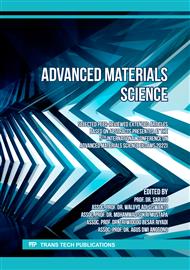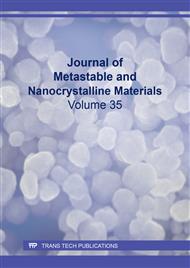p.1
p.11
p.19
p.25
p.33
Comparative X-Ray Diffraction (XRD) Study on the Synthesis of Natural Based Magnetic Silica Nanoparticles
Abstract:
The aim of this study was to compare the synthesis process of magnetic silica nanoparticles (Fe-SNP) through the analysis of X-ray Diffraction (XRD) results. Fe3O4 magnetic nanopowders was synthesized by ultrasonic assisted co-precipitation and Fe-SNP was synthesized by direct mixing method of sodium silicate (Na2SiO3) and magnetite (Fe3O4) and the sol-gel method. Silica sludge was used as a silica source from Indonesia geothermal power plant waste. The synthesized of Fe-SNP is the functionalization of Fe3O4 with silica. Variations concentration of Na2SiO3 is used for the direct mixing method and variations of Fe3O4 form is used for the sol-gel method. Particles formed and particle size were characterized by XRD. The XRD results showed that there is no SiO2 phase in the sample synthesized by direct mixing method while two phases of SiO2 and Fe3O4 were found in the sample synthesized by sol-gel method. The size of the Fe3O4 nanoparticles calculated with Scherer’s formula and it obtained 19.9 nm, while the Fe3O4 nanoparticles with the addition of 20 mL and 6 mL Na2SiO3 concentrations were 6,53 nm and 10,23 nm. For the sol-gel method the size of Fe3O4 nanoparticles obtained was 11,03 using Fe3O4 powders and 9,86 using Fe3O4 solutions.
Info:
Periodical:
Pages:
25-31
Citation:
Online since:
February 2023
Keywords:
Price:
Сopyright:
© 2023 Trans Tech Publications Ltd. All Rights Reserved
Share:
Citation:



